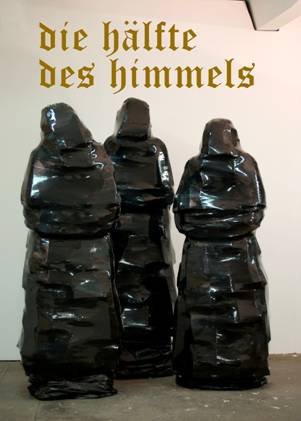Antje Blumenstein
dal 24/10/2008 al 10/11/2008
Segnalato da
24/10/2008
Antje Blumenstein
Galerie Martin Mertens, Berlin
Half of heaven. In the exhibited group of works, Blumenstein deals with themes of religion and its handling in regards to the implementation of non-intrinsic purposes. Belief as a reassurance in regards to moral questions, or its abuse through religious fanatics constitute problems, that also influence our contemporary secular society.

"It is trivial that we can neither prove nor disprove the existence of a
supernatural creature. But this simply means that the only supporter of
their existence the ‘wish’ is. This, then, doesn’t negate their existence,
but the belief in them."
We are proud to present Antje Blumenstein’s second solo show at Martin
Mertens.
In the exhibited group of works, Blumenstein deals with themes of religion
and its handling in regards to the implementation of non-intrinsic purposes.
Belief as a reassurance in regards to moral questions, or its abuse through
religious fanatics constitute problems, that also influence our contemporary
secular society.
Images and headlines of popular media are juxtaposed with current texts or
quotes of art history and checked for their usability.
Blumenstein employs ruptures, reallocations, and ironic inversion either to
reveal social networks of our cultural imprint or to explore fictions and
real-life examples.
Black figures dominate the main room of the gallery. Monks –borrowed from
the “Tomb of Philippe Pot”, a 15th century stone sculpture- are spread on
islands. Seemingly lamenting, they turn their faces to each other.
Executed in glossy PE-film, they, however, appear as the embodiment of the
Bad in “Star Wars”, or remind the viewer of slightly freezing individuals
that are immersed in a conversation.
Across from them, the writing “half of heaven” shines in a bright light.
Is it the Good that’s shown here, similar to a dualism? Is “half of heaven”,
a term coined by Mao Tse-Tung, a welfare promise? Or is everything put into
perspective in the end in regards to our conscience of our own contingency
as evoked by the piece “es sterben immer nur die anderen” (“it’s always the
others that die”). The Styrofoam-figure is overgrown with floral forms and
resembles a tomb.
Blumenstein uses various types of media to create her pieces that vary
in form, material and genre. Sculpture and installation are as important as
painting and collage. “Cheap Consumerism” materials and utensils from a
hardware store, like Styrofoam, polyurethane foam, a light tube or packaging
material are presented next to classical oil painting – “Plato
terrorists” next to “religious unmusical” (Blumenstein).
Quote:
Ernst Tugendhat, „Über Religion“ in Anthropologie statt Metaphysik, Munich:
Beck 2007
Opening: Saturday, October 25th 2008, 6 pm
Galerie Martin Mertens
Brunnenstrasse 185 - Berlin
Tuesday to Saturday 12:00 to 18:00 & by prior arrangement
Free admission



